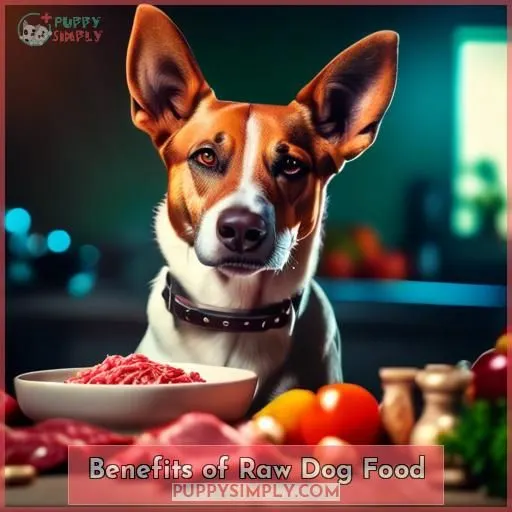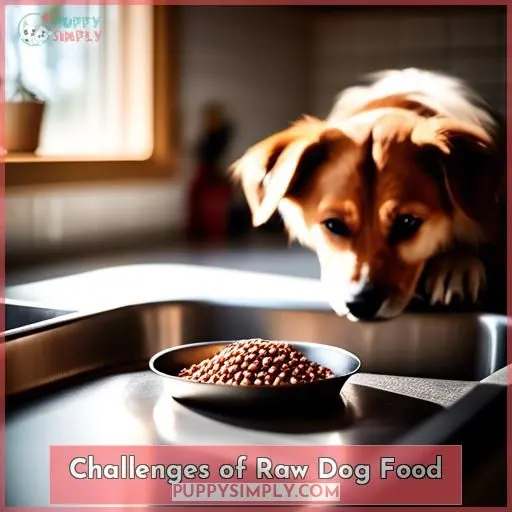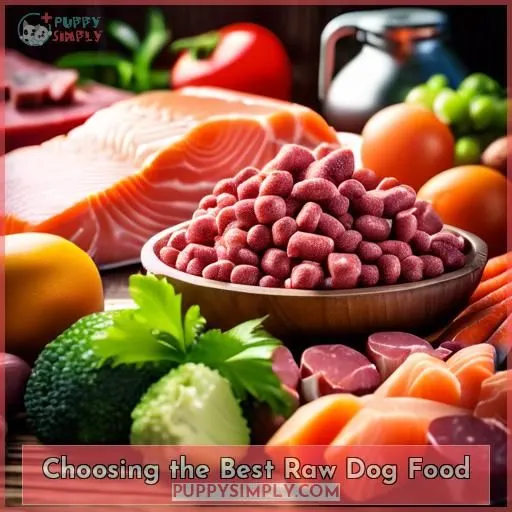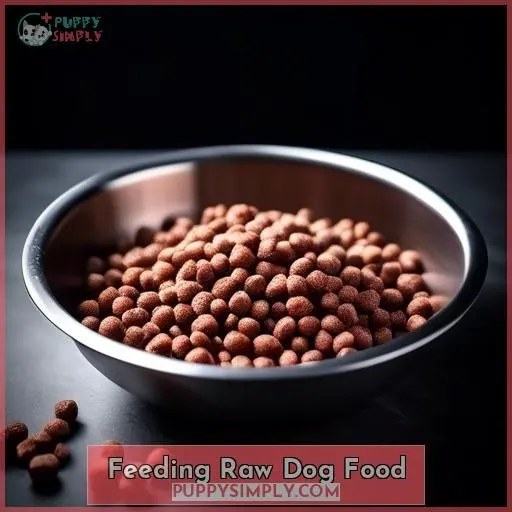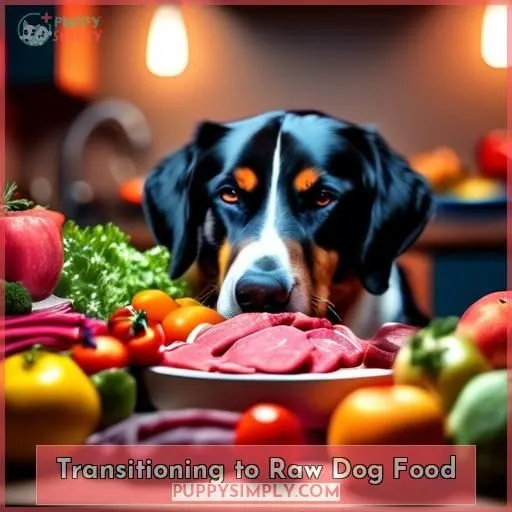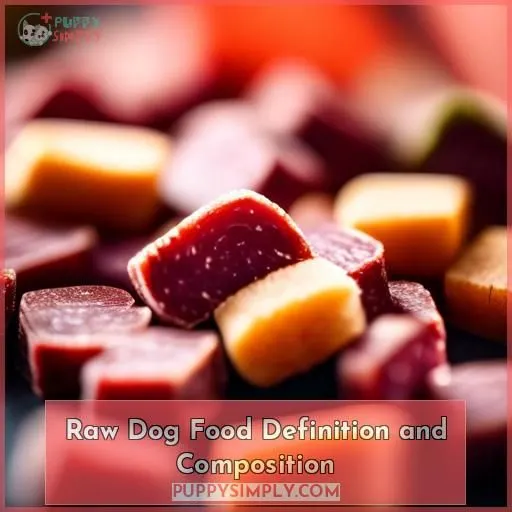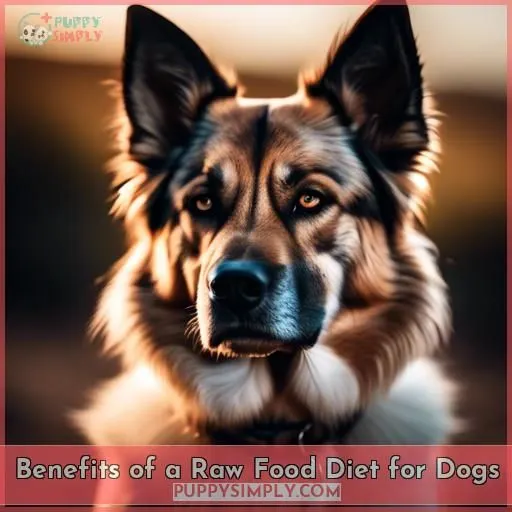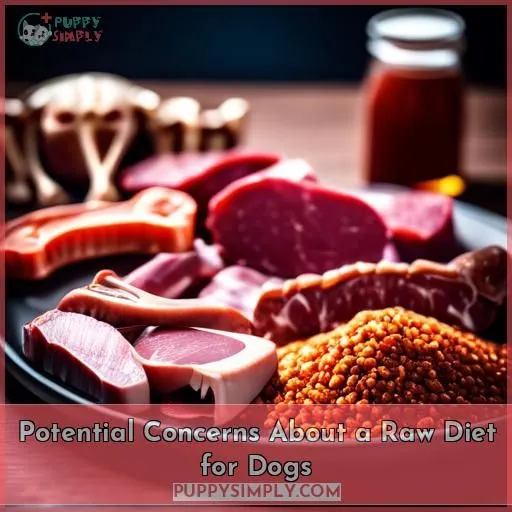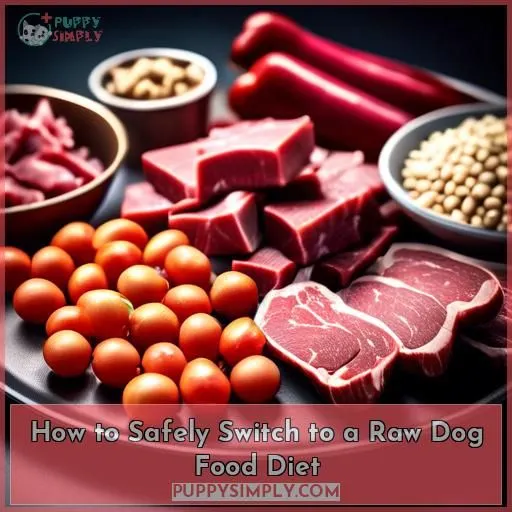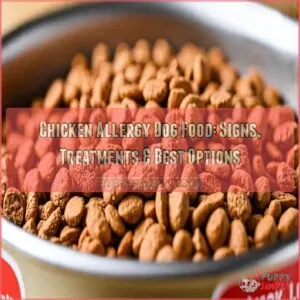This site is supported by our readers. We may earn a commission, at no cost to you, if you purchase through links.
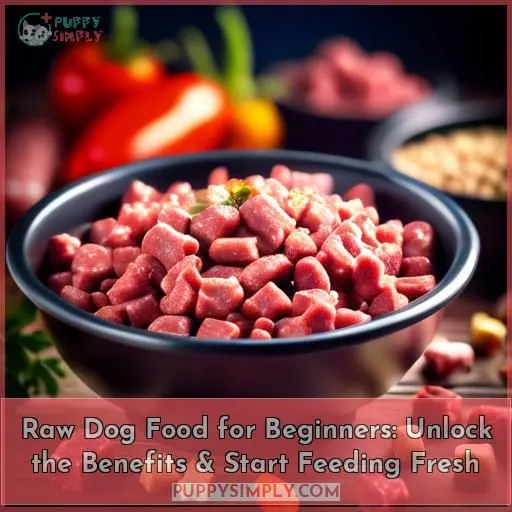
Switching to raw dog food may seem daunting, but it can provide immense benefits for your furry friend’s health.
While there are challenges like safety concerns and higher costs, choosing high-quality proteins and ensuring a balanced diet can reduce allergy symptoms, improve skin/coat, boost energy, and aid renal function.
Start by slowly transitioning, monitoring reactions, and consulting your vet.
Proper handling practices like defrosting and storing the food safely are crucial.
With time and care, you’ll unlock the advantages of raw dog food for beginners and see your pup thrive.
Table Of Contents
- Key Takeaways
- What is Raw Dog Food?
- Benefits of Raw Dog Food
- Challenges of Raw Dog Food
- Choosing the Best Raw Dog Food
- Feeding Raw Dog Food
- Transitioning to Raw Dog Food
- Raw Dog Food Definition and Composition
- Benefits of a Raw Food Diet for Dogs
- Potential Concerns About a Raw Diet for Dogs
- How to Safely Switch to a Raw Dog Food Diet
- Frequently Asked Questions (FAQs)
- Conclusion
Key Takeaways
- Raw dog food can provide immense benefits for a dog’s health, including improved skin and coat, increased energy, and better renal function.
- Choosing high-quality proteins and ensuring a balanced diet can reduce allergy symptoms and improve overall health.
- Proper handling practices like defrosting and storing the food safely are crucial to ensure the safety of the dog and the owner.
- Transitioning to raw dog food requires careful planning, monitoring, and veterinary consultation to ensure a smooth and successful switch.
What is Raw Dog Food?
Raw dog food is an uncooked diet that includes a mixture of raw meat, organs, and bones.
It’s designed to mimic the diet of dogs’ ancestors as wild carnivores and is believed to have several benefits, such as improved skin and coat health, increased energy levels, and better dental health.
However, raw dog food also comes with challenges, including safety concerns, higher cost, time-consuming meal preparation, and the need for safe food handling practices.
To choose the best raw dog food, it’s essential to ensure the diet is complete and balanced, consider BARF or Whole Prey diets, choose high-quality animal proteins, rotate protein sources, and consider freeze-dried or dehydrated options.
Feeding raw dog food requires determining the appropriate portion size, preparing food safely and hygienically, establishing a consistent feeding schedule, defrosting food properly, and storing it correctly.
Transitioning to raw dog food can be done quickly or slowly, and it’s crucial to monitor the dog for any adverse reactions and consult with a veterinarian if necessary.
Benefits of Raw Dog Food
If you’re considering a raw dog food diet, you’ll be pleased to know that it can offer numerous benefits for your furry companion. Feeding raw can potentially reduce allergy symptoms, improve skin and coat health, boost energy levels, aid renal function, and enhance metabolic efficiency, making it a wholesome choice for your pup’s overall well-being.
Reduces Allergy Symptoms
Raw dog food can help reduce allergy symptoms by providing a diet free from common allergy triggers found in commercial pet foods. The raw ingredients are easier for your dog’s immune system to process, reducing the risk of an immune response.
Raw dog food also contains digestive enzymes that help break down the food, reducing the risk of bacterial contamination.
However, it’s crucial to consult with a veterinarian before transitioning your dog to a raw diet, as they can provide valuable advice on the process and any potential concerns.
Improves Skin and Coat Health
Improve your dog’s skin and coat health by feeding them a raw dog food diet.
With natural shine, reduced inflammation, and improved texture, raw meat-based diets can enhance your pet’s appearance.
The raw food diet allows for better mineral absorption and vitamin intake, ensuring a healthier, more vibrant coat.
To achieve optimal results, consider a BARF or Whole Prey diet.
Choose high-quality animal proteins and rotate protein sources.
Boosts Energy Levels
Boosting your dog’s energy levels is one of the many benefits of feeding them a raw food diet. Raw meat, bones, and organs are packed with vitamins, minerals, and antioxidants that can help your dog’s blood sugar levels stay stable, leading to more consistent and sustainable energy. The high protein content in raw dog food is also essential for building and repairing muscle tissue, which can support joint health and improve overall physical performance.
However, it’s crucial to ensure that your dog’s raw food diet is complete and balanced, as a deficiency in certain nutrients could negatively impact their energy levels. Consult with a veterinarian or a raw dog food specialist to create a diet that meets your dog’s specific nutritional needs.
Aids Renal Function
A raw dog food diet can significantly aid renal function.
By providing a balanced diet rich in high-quality protein sources, you can support your dog’s kidney health.
However, it’s crucial to ensure a complete and balanced diet, consider supplements, and transition your dog carefully.
USDA-certified human-grade meats are a safe choice for raw diets.
Raw meat isn’t inherently dangerous for dogs, but precautions should be taken when handling and storing raw dog food.
Enhances Metabolic Efficiency
Enhancing your dog’s metabolic efficiency is one of the many benefits of feeding them a raw diet. Raw dog food is rich in nutrients that support your dog’s overall health, including gut health, immune system function, and digestion. By feeding your dog a raw diet, you can help them maintain a healthy weight, improve their dental health, and boost their energy levels.
Raw dog food is designed to mimic the natural diet of dogs, which is rich in protein and other essential nutrients. When you choose a raw diet for your dog, you’re providing them with a diet that’s more in line with their biological needs. This can lead to improved digestion, better nutrient absorption, and a stronger immune system.
To ensure that your dog is getting the most out of their raw diet, it’s important to choose a high-quality, complete and balanced diet. Look for recipes that include a variety of protein sources, such as beef, chicken, lamb, or pork, as well as fruits, vegetables, and other nutrient-dense ingredients.
If you’re considering transitioning your dog to a raw diet, it’s important to do so gradually and under the guidance of a veterinarian. This will help ensure that your dog’s nutritional needs are met and that they adjust to the new diet without any adverse effects.
Challenges of Raw Dog Food
While raw dog food offers numerous benefits, transitioning to this diet comes with its challenges. You’ll face higher costs, time-consuming meal preparation, potential safety concerns regarding foodborne illnesses, and resistance from some veterinarians who may not approve of this feeding approach.
Proper handling and storage practices are crucial to minimize health risks associated with raw meat.
Safety Concerns
Switching to raw dog food isn’t without its hurdles. Here’s the scoop on safety concerns:
- Contamination Risk: Raw diets can harbor bacteria, making food hygiene paramount.
- Nutritional Deficiencies: Without veterinary approval, you might miss essential nutrients.
- Bacterial Growth: Improper storage spells trouble.
Higher Cost
Raw dog food can be more expensive than traditional kibble.
However, there are ways to make it more affordable.
One strategy is to use raw pet food as a topper or base for dry dog food.
This can help stretch your budget while still providing health benefits.
Another option is to buy raw food in bulk.
Buying in bulk can often be more cost-effective than purchasing smaller quantities.
Additionally, choosing more affordable proteins, such as chicken and beef, can help reduce costs without compromising nutritional value.
Time-consuming Meal Prep
Raw dog food can be a healthier and more natural option for your furry friend, but it comes with its own set of challenges. One of these challenges is the time-consuming meal prep required to ensure your dog is getting a balanced and nutritious diet.
- Meal Planning: Plan your dog’s meals ahead of time to ensure you have all the necessary ingredients on hand. This will save you time and effort in the long run.
- Batch Prepping: Prepare larger batches of raw dog food and store them in the freezer for later use. This will reduce the time spent on meal prep and ensure you always have a supply of fresh food.
- Food Storage: Store raw dog food properly to maintain its freshness and safety. Keep it frozen until use, and defrost only what you need.
- Sourcing Ingredients: Find reliable sources for high-quality, raw ingredients. This may involve researching local farmers or online suppliers.
- Time Management: Be mindful of your time and schedule. Prepare raw dog food when it’s convenient for you, and consider batch prepping to save time.
May Not Be Approved by Vets
After tackling the time-consuming nature of meal prep, you might hit another roadblock: vet concerns.
Many vets raise eyebrows at raw diets, citing safety and transition risks.
They’re not just being sticklers; their worries stem from genuine care.
While the cost implications and time constraints of raw feeding are manageable, convincing your vet requires a blend of patience and solid evidence.
Requires Safe Food Handling Practices
When it comes to feeding your furry friend a raw diet, it’s crucial to prioritize safe food handling practices to prevent potential health risks. Raw dog food, while offering numerous benefits such as improved skin and coat health, energy levels, and renal function, can also pose challenges if not handled properly.
- Bacterial contamination: Raw meat, whether for humans or pets, can contain bacteria such as Salmonella, E. coli, and Listeria. These bacteria can cause foodborne illnesses if not handled correctly.
- Cross-contamination: Keep raw meat and other ingredients separate to prevent cross-contamination. Use dedicated cutting boards, utensils, and surfaces for raw meat to minimize the risk of bacteria transfer.
- Kitchen hygiene: Maintain cleanliness and hygiene in your kitchen. Regularly wash your hands with soap and warm water before and after handling raw meat. Clean and sanitize all equipment and surfaces used for raw meat preparation.
- Storage: Store raw dog food in airtight containers in the refrigerator or freezer to maintain its freshness and minimize bacterial growth.
- Defrosting: Thaw raw dog food properly before feeding it to your pet. Use a refrigerator or cold water to defrost, and discard any food that has been left out at warm temperatures for an extended period.
Choosing the Best Raw Dog Food
When choosing the best raw dog food, it’s crucial to ensure the diet is complete and balanced, providing all the essential nutrients your furry friend needs. You may want to consider BARF (Biologically Appropriate Raw Food) or whole prey models, which mimic a dog’s natural diet, and choose high-quality animal proteins while rotating protein sources to offer variety.
Ensure Diet is Complete and Balanced
To ensure your dog’s diet is complete and balanced when transitioning to a raw dog food diet, consider the following points:
- BARF vs. Whole Prey Diets: BARF (Bones and Raw Food) and whole prey diets are two popular options. BARF typically includes muscle meat, bones, organ meats, raw eggs, vegetables, and some dairy, while whole prey diets consist of complete animal carcasses, including the organs and bones. Both diets can be balanced if properly prepared and supplemented, but they require careful planning and knowledge of animal nutrition.
- Commercial Pet Foods: If you’re not confident in your ability to create a balanced raw diet, consider purchasing pre-prepared raw food from reputable sources. Look for options that are registered with the Pet Food Manufacturers Association and comply with EU nutrient profiles. These foods are governed by more stringent bacteriological rules than human-grade raw meat products.
- Veterinarian Approval: Consult with your veterinarian before making any significant changes to your dog’s diet. They can provide guidance on how to ensure the diet is balanced and safe for your pet.
- Stomach Upset Issues: Be aware that some dogs may experience stomach upset when transitioning to a raw food diet. Monitor your dog’s health closely during the transition period and be prepared to adjust the diet if necessary.
- Safe Food Handling Practices: Raw food diets require careful handling to avoid contamination with pathogens. Wash your hands thoroughly after handling raw meat and clean all surfaces and objects that come into contact with the meat.
Consider BARF or Whole Prey Diets
When considering a raw diet for your furry friend, BARF and Whole Prey diets are your go-to options.
These diets mimic what dogs would naturally eat in the wild, including bone marrow, organ meats, and the occasional raw fish.
It’s like giving your dog a backstage pass to nature’s banquet, ensuring they’re not missing out on any nutritional elements.
Choose High-quality Animal Proteins
To choose high-quality animal protein sources for your raw dog food, consider the protein source rotation, freeze-dried options, and dehydrated options.
Ethical sourcing is crucial to ensure the health and well-being of your dog.
It’s essential to note that variety is key to a balanced diet.
Rotate Protein Sources
Rotational feeding, a practice that involves changing your dog’s protein sources, is crucial for maintaining dietary balance and ensuring your pet receives a wide variety of essential nutrients. By rotating proteins, you can help your dog avoid food allergies and intolerances, as constant exposure to the same protein can lead to adverse reactions. Additionally, rotational feeding promotes a healthier digestive system by introducing different types of beneficial bacteria, which can improve your dog’s ability to break down new proteins and reduce upset stomachs.
To implement rotational feeding, consider the following steps:
- Choose a variety of high-quality protein sources: Include proteins from different animal sources, such as chicken, beef, lamb, and fish, to ensure your dog receives a wide range of amino acids.
- Vary the protein types: Switch between wet, dry, and raw food options to provide your dog with different textures and flavors.
- Monitor your dog’s reaction: Introduce new protein sources gradually, starting with small amounts and gradually increasing the proportion in their diet, to minimize the risk of digestive issues.
Consider Freeze-dried or Dehydrated Options
Consider freeze-dried or dehydrated raw dog food options to simplify your raw feeding journey.
These choices offer several advantages:
Extended shelf life
Convenient packaging
A more palatable texture for your dog
However, they may come with higher shipping costs and a limited variety compared to fresh raw.
Weigh the pros and cons to find the optimal solution for your furry friend’s dietary needs.
Feeding Raw Dog Food
When feeding raw dog food, it’s crucial to determine the appropriate portion size based on your dog’s weight, age, and activity level. You’ll also need to prepare the food safely by following proper hygiene practices, defrosting frozen meat correctly, and storing the raw ingredients at the right temperature to prevent contamination.
Determine Appropriate Portion Size
After zeroing in on the perfect raw dog food, it’s time to crack the code on portion size.
- Portion size calculation: Tailor meals to your dog’s weight; 2-3% is the golden rule.
- Feeding frequency: Twice a day keeps the hunger at bay.
- Raw meat sources: Variety is the spice of life.
- Offal inclusion: Don’t skimp on the organs.
- Bone content: Aim for balance, not a bone-a-thon.
Prepare Food Safely and Hygienically
Preparing raw dog food safely and hygienically is crucial to ensure your pet’s health and your own.
- Wash your hands thoroughly before and after handling raw food to avoid bacterial contamination.
- Use a diluted vinegar solution to clean surfaces, floors, bowls, and any other objects that come into contact with the raw food.
- Store raw food properly in the fridge or freezer to prevent bacterial growth.
- Avoid using plastic bowls, as they can harbor bacteria in scratches and cracks. Instead, opt for metal, glass, or ceramic dishes that are easier to clean and sanitize.
- Disinfect surfaces and utensils used for raw feeding with a natural disinfectant like diluted vinegar.
Establish a Consistent Feeding Schedule
Establishing a consistent feeding schedule is crucial when transitioning your dog to raw food.
- Feeding Frequency: Determine how often you’ll feed your dog. Some dogs may need three meals a day, while others may do well with two.
- Meal Timing: Try to feed your dog at the same time each day to maintain a routine. This can help with digestion and overall health.
- Meal Variety: Incorporate a variety of proteins and nutrients into your dog’s meals. This can help ensure they’re getting all the necessary vitamins and minerals.
Defrost Food Properly
Defrosting raw dog food properly is crucial for safety and nutritional balance. Follow these guidelines:
- Store raw dog food in cold storage to prevent bacterial growth.
- Portion out the food and freeze in individual portions.
- Thaw in the refrigerator overnight or use a microwave on the defrost setting.
- Never defrost at room temperature or in hot water.
- Use portion control to ensure your dog gets a balanced diet.
Store Food Correctly
To store raw dog food correctly, follow these guidelines:
- Freezer Storage: Keep raw dog food frozen until use. Store it in a secure container to prevent bacterial growth and spoiling.
- Fridge Storage: If you choose to thaw a portion of raw dog food in the fridge, ensure it’s stored in an airtight container and used within a few days.
- Portioning: Divide raw dog food into appropriate portions based on your dog’s weight and feeding schedule. This helps maintain freshness and reduces waste.
- Leftovers Disposal: Immediately refrigerate or discard any leftover raw dog food to prevent bacterial growth and spoiling.
Transitioning to Raw Dog Food
When transitioning your dog to a raw food diet, you have two main options:
A quick switch involves fasting your dog for 12 hours, then abruptly switching to raw food.
A slow switch gradually introduces raw food over several days.
Whichever method you choose, it’s crucial to use digestive supplements.
Monitor your dog closely for any adverse reactions.
Consult with your veterinarian, especially if your dog has any underlying health conditions.
Quick Switch
If you’re eager to embark on your dog’s raw food journey, you might be considering a quick switch, also known as a rapid transition. This method involves fasting your dog for 12 hours and then introducing raw food in the morning.
- Start with a simple and lean protein: Begin with a protein like chicken or turkey to help your dog adjust to the new diet. After a few days, you can introduce other proteins.
- Gradually rotate proteins: Over the next few days, introduce different proteins to build your dog’s tolerance and allow them to adjust to a variety of foods.
- Monitor your dog’s reaction: Keep an eye on your dog’s stool consistency and overall health during the transition. If you notice any digestive issues, adjust the amount of raw food you’re feeding accordingly.
Slow Switch
When transitioning your dog to a raw diet, a slow switch is often recommended.
This involves gradually introducing raw food over several days, allowing your dog’s digestive system to adjust.
Portion sizes should be determined based on your dog’s weight.
You may consider using digestive supplements to support gut health during this transition.
It’s important to monitor your dog for any adverse reactions and consult with a veterinarian if necessary.
Superfoods like carrots, celery, broccoli, and green beans can be incorporated into your dog’s diet for added health benefits.
Use Digestive Supplements
When transitioning your dog to a raw diet, it’s crucial to consider digestive issues. The digestive system may need time to adjust to the new food, and the transition period can vary depending on factors like age, weight, and activity level. A gradual switch, such as the slow switch method, is recommended for most dogs, which involves starting with a 75% kibble and 25% raw food ratio for the first week, then gradually increasing the raw food portion over time.
During the transition, it’s essential to monitor your dog’s stool consistency. Loose stools may indicate that the transition is happening too quickly, and you should adjust the feeding schedule accordingly. Additionally, digestive supplements can be helpful for dogs that may not be able to produce adequate digestive enzymes, such as those with pancreatitis, leaky gut, malabsorption, IBD, EPI, or SIBO.
It’s also worth noting that the frequency of feeding raw food can affect digestion. Most dogs prefer two meals per day, but some may do better with more frequent meals. Consult with your veterinarian for personalized advice on the best feeding schedule for your dog.
Monitor Dog for Any Adverse Reactions
When transitioning your dog to a raw food diet, it’s crucial to monitor them for any adverse reactions.
Side effects such as stomach upset, allergic reactions, or gastrointestinal issues can occur, especially during the initial stages of the transition.
Keep an eye on your dog’s behavior and health.
If you notice any concerning symptoms, consult with your veterinarian for advice.
Consult With a Veterinarian if Necessary
Consulting with a veterinarian is crucial when transitioning your dog to a raw food diet.
Vets have a wealth of knowledge and experience that can help ensure a smooth and safe transition. They can provide valuable insights on the dietary needs of your dog, address any concerns you may have, and offer advice on how to properly handle and store raw food to minimize risks.
Additionally, vets can help you navigate any potential challenges that may arise during the transition, such as digestive issues or changes in energy levels.
Raw Dog Food Definition and Composition
You’re entering the realm of raw dog food, where an uncooked diet of raw meat, organs, and bones reigns supreme. Dogs possess the potent stomach acid and digestive enzymes designed to thrive on animal parts alone – an evolutionary adaptation that supports this biologically appropriate diet.
Uncooked Diet for Dogs
If you’re considering a diet change for your furry friend, look no further than raw dog food.
An uncooked diet made up of raw meat, organs, and bones is biologically designed to thrive off animal parts alone.
This diet can provide numerous benefits for your dog’s health, such as reducing allergy symptoms, improving skin and coat health, boosting energy levels, aiding renal function, and enhancing metabolic efficiency.
However, it’s crucial to ensure the diet is complete and balanced.
Consider BARF or Whole Prey diets.
Choose high-quality animal proteins and rotate protein sources.
Additionally, raw dog food requires safe food handling practices.
It may not be approved by all veterinarians.
Mixture of Raw Meat, Organs, and Bones
When it comes to raw dog food, the mixture of raw meat, organs, and bones is a crucial aspect of this dietary choice. This subtopic is often overlooked, but it’s essential to understand the composition of raw dog food to make an informed decision about whether it’s suitable for your furry friend.
Raw dog food is a fresh, unprocessed diet that consists of raw meat, organs, and bones. This diet is biologically appropriate for dogs, as their ancestors historically consumed these types of foods in the wild. The digestibility of raw dog food is higher than that of processed kibble, which is often filled with fillers and by-products. The nutrient density of raw dog food is also more sustainable and ethical, as it can be sourced locally and supports sustainable farming practices.
However, it’s important to note that raw dog food requires careful handling and preparation to ensure safety. This includes safe food handling practices, such as washing hands and cleaning surfaces and objects that come into contact with the meat. Additionally, raw dog food should be stored properly to prevent contamination and spoilage.
In terms of transitioning to a raw dog food diet, it’s recommended to gradually introduce the food over several days, as a sudden switch can cause digestive upset. It’s also crucial to monitor your dog for any adverse reactions and consult with a veterinarian if necessary.
Dogs Have Strong Stomach Acid and Digestive Enzymes
Dogs have strong stomach acid and digestive enzymes that allow them to safely digest raw meat.
Their digestive system is designed to break down proteins, fats, and carbohydrates.
It uses enzymes like pepsinogen, trypsin, and chymotrypsin to convert solid matter into a more easily digestible form.
However, it’s important to note that while dogs can safely digest raw meat, there are potential risks associated with feeding raw diets.
These risks include the risk of nutritional deficiencies and the presence of harmful bacteria like Salmonella, Listeria, and E.
To minimize these risks, it’s crucial to follow safe handling practices.
Ensure the raw meat is properly stored, defrosted, and cooked before feeding it to your dog.
Biologically Designed to Thrive Off Animal Parts Alone
Raw dog food is often described as an evolutionary diet, designed to mimic what your dog’s ancestors would have naturally consumed in the wild. This diet is rich in raw meat, organs, and bones, which are packed with essential nutrients that support your dog’s digestive health and overall well-being.
Dogs have strong stomach acid and digestive enzymes that allow them to safely digest raw meat, making it an ideal choice for those seeking a more natural, unprocessed diet for their furry friends. In contrast, kibble, which is often made from grains and other processed ingredients, can be more difficult for dogs to digest, as they lack the necessary enzymes to break down these components.
When transitioning to a raw diet, it’s essential to consider the benefits and potential challenges. On the positive side, raw dog food can improve your dog’s skin and coat health, boost their energy levels, and support renal function. However, it’s crucial to handle the food safely and ensure that it’s properly stored and prepared to avoid any potential risks associated with raw meat, such as bacterial contamination.
To choose the best raw dog food, consider a complete and balanced diet that includes a variety of high-quality animal proteins and rotates protein sources to ensure your dog receives a well-rounded nutritional profile. Additionally, consider freeze-dried or dehydrated options for convenience and ease of storage.
Benefits of a Raw Food Diet for Dogs
A raw food diet for your dog offers numerous benefits beyond just better digestion. By feeding your canine companion a diet rich in natural, unprocessed ingredients, you’ll likely notice improvements in their skin and coat condition, sustained energy levels, better weight management, enhanced dental health, and an increased enthusiasm for mealtime.
Smaller, Firmer Stool
Picture this: your dog’s digestive system functioning at its best, producing smaller, firmer stools.
No more stomach problems, digestive issues, loose stools, gas, or vomiting.
This is the reality of a raw food diet for dogs. It’s not just about improving their health; it’s about giving them the best possible start to life.
Improved Skin and Coat
As you embark on the journey to switch your dog to a raw diet, you’ll soon discover the many benefits it has on their skin and coat. By feeding your dog raw meat, organs, and bones, you’re providing them with nutrients that are more bio-available and easier for their digestive system to break down. This results in a healthier, shinier coat and improved skin health.
Raw dog food diets contain essential fatty acids, such as omega-3 fatty acids found in sprats, chia seeds, and flax seeds, which promote healthy skin and a shiny, soft coat. Additionally, raw foods are rich in enzymes, which help with cellular regeneration, and intracellular moisture, ensuring your dog stays hydrated.
By transitioning to a raw diet, you’ll notice a reduction in dandruff, dry skin, and itchiness, as the nutrients are more easily absorbed and utilized by your dog’s body. This can also provide relief for dogs suffering from food allergies, as raw food diets can alleviate allergic reactions and provide anti-inflammatory benefits.
To ensure the best results, it’s crucial to choose a complete and balanced raw dog food that includes a variety of meats and organs, as well as fruits and vegetables for added vitamins and minerals. Additionally, consider supplementing with high fiber vegetables, such as spinach, kale, and parsley, to support gut health and further enhance skin and coat health.
Weight Control
Transitioning to a raw dog food diet can be a daunting task, but it’s not impossible. With the right approach, you can ensure your dog is getting the nutrients they need while also enjoying the benefits of a raw diet.
- Gradual Transition: Don’t rush the process. Gradually wean your dog off their current food over a period of 7-14 days. Start with a small amount of raw food and gradually increase it while decreasing the amount of their current food. This will help their digestive system adjust to the new diet.
- Consult a Professional: Consult with a veterinarian or a certified animal dietician to ensure you’re providing a balanced diet. They can help you understand your dog’s nutritional needs and recommend appropriate food sources.
- Choose High-Quality Ingredients: Select high-quality, fresh ingredients for your dog’s raw meals. This includes muscle meat, organs, bones, fruits, and vegetables. Make sure the ingredients are free from contaminants and harmful additives.
- Maintain a Consistent Feeding Schedule: Establish a consistent feeding schedule for your dog. This will help them adjust to the new diet and ensure they’re getting the nutrients they need.
- Monitor Your Dog’s Health: Keep an eye on your dog’s health during the transition. If you notice any adverse reactions, such as diarrhea or vomiting, consult with your veterinarian.
- Consider Supplements: Depending on your dog’s individual needs, you may need to supplement their diet with additional vitamins and minerals. Consult with a veterinarian or animal dietician to determine the appropriate supplements.
Better Dental Health
Raw dog food can significantly improve your dog’s dental health. Here’s how:
- Mechanical cleaning: The act of chewing raw, meaty bones naturally scrapes away plaque and tartar from your dog’s teeth. This mechanical cleaning action helps to prevent the buildup of harmful bacteria, reducing the risk of gum disease and other dental issues.
- Reduced carbohydrates: Kibble diets are typically high in carbohydrates, which can lead to the formation of plaque and tartar. Raw dog food recipes contain a lower carbohydrate content, which can help to minimize plaque and tartar accumulation on your dog’s teeth.
- Natural enzymes: Raw meat contains natural enzymes that can help to break down bacteria and food particles in your dog’s mouth. These enzymes contribute to a healthier oral environment and can help to reduce bad breath and promote overall dental health.
- Fresh breath: Raw diets can help prevent tartar build-up because raw diets don’t stick to the teeth, unlike diets that are high in starchy carbohydrates. Raw diets are a natural dental abrasive that effectively acts as a toothbrush when your pet is eating.
Incorporating raw dog food into your dog’s diet can be a game-changer for their dental health. It’s essential to transition your dog gradually to a raw diet to ensure a smooth transition and minimize the risk of digestive upset. Monitor your dog’s dental health regularly and consult your veterinarian for advice on the best oral care practices.
More Mealtime Excitement
Switching from kibble to raw can be like turning mealtime into a treasure hunt for your dog. With more mealtime variety, even picky eaters will find themselves wagging with anticipation. This enrichment goes beyond taste; it’s about nurturing their digestive health and sidestepping food allergies. Think of it as a culinary adventure that keeps tails spinning and bowls empty.
Potential Concerns About a Raw Diet for Dogs
You may have concerns about the safety, cost, time commitment, and potential disapproval from your veterinarian when considering a raw diet for your dog. While these are valid points, it’s crucial to approach them with an open mind and gather information from reliable sources to make an informed decision.
Safety
Safety is a crucial consideration when transitioning to a raw dog food diet. Here are four key points to keep in mind:
- Salmonella risk: Raw meat can contain Salmonella bacteria, which can cause illness in dogs. Ensure proper food handling practices to minimize this risk.
- E. coli: E. coli is another bacterial contaminant that can be present in raw meat. Proper handling and cooking can reduce the risk.
- Parasite infection: Wild animal carcasses may harbor parasites. Freezing meat kills off these parasites, but always take precautions when handling raw meat.
- Handling practices: Wash hands thoroughly after handling raw meat and clean all surfaces that come into contact with it.
Cost
When considering the cost of feeding your dog a raw diet, it’s essential to weigh the potential benefits against the financial investment. Raw dog food can be more expensive than traditional kibble, but it may offer long-term savings in terms of reduced vet bills and potential health improvements.
To help you navigate the cost of raw dog food, we’ve compiled a table comparing the prices of various options:
| Diet Type | Average Monthly Cost |
|---|---|
| Commercial raw dog food | $210 – $225 |
| Homemade raw dog food | $120 |
| Standard dry dog food | $50 – $65 |
Keep in mind that these costs can vary depending on the brand, quality, and where you purchase the food. However, by considering budgetary aspects and financial planning, you can make an informed decision about whether a raw diet is a feasible option for you and your dog.
Time
After considering the cost, let’s tackle the time aspect. Diving into raw feeding isn’t just a financial commitment; it’s a time investment too.
- Juggling time management becomes a daily puzzle.
- Meal planning morphs into a culinary adventure.
- Navigating food safety feels like a tightrope walk.
- Hunting for suppliers turns into a treasure hunt, with budget constraints as your map.
Disapproving Vet
As a responsible pet owner, you want the best for your furry friend. You’ve heard about the benefits of raw dog food, but you’re concerned about the potential disapproval from your vet. It’s important to understand that your veterinarian‘s knowledge may be limited, as they’re trained to treat a variety of species and often rely on commercial pet food for nutrition education. However, raw feeding is gaining popularity and acceptance among some vets, especially those with an interest in holistic and alternative therapies.
The key to successfully transitioning your dog to a raw diet is to ensure that the diet is complete and balanced. This can be achieved by following a BARF (Biologically Appropriate Raw Food) or Whole Prey diet, which includes a variety of animal proteins, organs, and bones. You can also consider freeze-dried or dehydrated options, which offer convenience and safety.
It’s also crucial to choose high-quality animal proteins and rotate protein sources to avoid nutrient deficiencies. Vegetables and fruits can supplement the diet, providing essential vitamins, minerals, and antioxidants. However, it’s essential to be aware of potential nutrient deficiencies, such as zinc, vitamin E, iodine, magnesium, and calcium, which can lead to health issues if not addressed.
How to Safely Switch to a Raw Dog Food Diet
Transitioning your dog to a raw food diet can be a daunting task, but with the right approach, it can be a smooth and successful process. There are two main methods for transitioning: a quick switch and a slow switch. The quick switch involves fasting your dog for 12 hours and then abruptly switching to raw food.
The slow switch involves gradually introducing raw food over several days. It’s essential to monitor your dog for any adverse reactions during this time and consider using digestive supplements to support gut health.
If you’re unsure about the transition, it’s always a good idea to consult with a veterinarian.
- Quick Switch: Fast your dog for 12 hours and then switch to raw food abruptly.
- Slow Switch: Gradually introduce raw food over several days.
- Digestive Supplements: Use supplements to support gut health during the transition.
- Veterinarian Consultation: Consult with a vet if you have concerns or questions.
- Monitor Adverse Reactions: Keep a close eye on your dog for any negative reactions to the new diet.
Frequently Asked Questions (FAQs)
What is the difference between raw and cooked dog food?
Raw dog food is uncooked, containing meat, organs, and bones. Cooked dog food is processed, with ingredients cooked at high temperatures. Raw diets mimic a dog’s ancestral diet, while cooked provides easier digestion for some dogs.
Can raw dog food be stored in the fridge?
Yes, you can store raw dog food in the fridge. Keep it refrigerated at 40°F or below for up to 3-5 days. Proper storage prevents bacterial growth, ensuring your pup’s safety.
How do I transition my dog to a raw food diet?
Start slowly, mixing raw with their current food over 7-10 days. Monitor closely for digestive issues. Consult your vet for guidance.
Is it safe to feed my dog raw bones?
Yes, it’s generally safe if done properly. Be sure to use raw bones from reputable sources and supervise your pup when chewing to prevent choking hazards or obstructions.
What are the benefits of a raw food diet for dogs?
A raw food diet offers numerous benefits for dogs, including improved digestion, shinier coats, smaller stools, and more energy. However, proper preparation and handling are crucial to ensure safety.
Conclusion
Embracing raw dog food for beginners unlocks a world of potential benefits, from improved coat and skin to boosted energy levels. While challenges exist, carefully selecting high-quality proteins and ensuring a balanced diet can mitigate concerns. By slowly transitioning under veterinary guidance and adhering to proper handling practices, you’ll pave the way for your furry companion’s optimal health and vitality.


